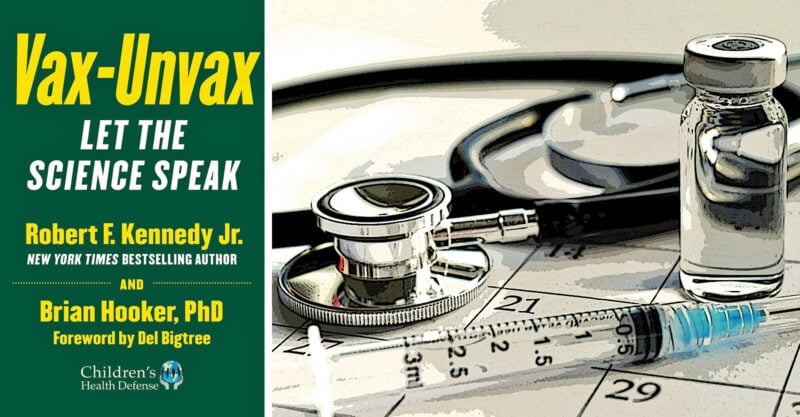10 Years After HHS Asked CDC to Study Safety of Childhood Vaccine Schedule, CDC Hasn’t Produced It
In Chapter 2 of “Vax-Unvax: Let the Science Speak,” Robert F. Kennedy Jr. and I present the very few studies examining the long-term and cumulative effects on children of administering all of the vaccines listed on the Centers for Disease Control and Prevention’s infant/childhood vaccination schedule.
Miss a day, miss a lot. Subscribe to The Defender's Top News of the Day. It's free.
In 2013, the National Vaccine Program Office of the U.S. Department of Health and Human Services (HHS) commissioned an update of earlier findings on the lack of evidence to support claims that the Centers for Disease Control and Prevention (CDC) infant/child vaccination schedule was safe.
The Institute of Medicine (IOM) committee, charged with producing the update, found that “few studies have comprehensively assessed the association between the entire immunization schedule or variations in the overall schedule and categories of health outcomes, and no study has directly examined health outcomes and stakeholder concerns in precisely the way that the committee was charged to address in its statement of task.”
According to the IOM committee, “studies designed to examine the long-term effects of the cumulative number of vaccines or other aspects of the immunization schedule have not been conducted.”
The lack of information on the overall safety of the vaccination schedule was so compelling that the committee then recommended HHS incorporate the study of the safety of the overall childhood immunization schedule into its processes for setting priorities for research, “recognizing stakeholder concerns, and establishing the priorities on the basis of epidemiological evidence, biological plausibility, and feasibility.”
The IOM also recommended the CDC use its private database, the Vaccine Safety Datalink (VSD), to study the overall health effects of the vaccination schedule using retrospective analyses.
Ten years later, the CDC has yet to do such a comparison study, even though it is sitting on a vast repository of data in the VSD, which include comprehensive medical records for more than 10 million individuals and 2 million children.
The VSD also contains records for a significant number of unvaccinated children, yet the CDC refuses to compare the health outcomes of vaccinated children to completely unvaccinated children.
The CDC also prohibits VSD outside researchers from accessing the VSD data so they can do the studies.
I was fortunate enough to be one of the researchers who had VSD access as I worked with Dr. Mark R. Geier and his son, David Geier, on a series of studies on thimerosal-containing vaccines in the early 2010s.
However, the CDC subsequently revoked the Geiers’ access because one of the health maintenance organizations (HMO) participating in the VSD project did not like the results the Geiers were obtaining, tying thimerosal exposure to a variety of childhood chronic disorders including autism spectrum disorder, attention-deficit/hyperactivity disorder (ADHD), birth defects, acute ethylmercury poisoning, fetal/infant/childhood death, premature puberty, emotional disturbance, tic disorder and developmental delays.
In Chapter 2 of “Vax-Unvax: Let the Science Speak,” Robert F. Kennedy Jr. and I present the very few studies completed on the entire infant/child vaccination schedule, including the groundbreaking study, “Pilot Comparative Study on the Health of Vaccinated and Unvaccinated 6- to 12-Year-Old U.S. Children,” by Anthony Mawson, doctor in public health.
Mawson and his co-authors studied fully vaccinated, partially vaccinated and unvaccinated home-schooled children for both infectious and chronic disease incidence.
Not only were chronic diseases more prominent in fully and partially vaccinated children — where the incidence of these diseases ranged from 30 times higher for allergic rhinitis to 3.7 times for neurodevelopmental disorders — but there also was a higher prevalence of infectious diseases like pneumonia and ear infections in vaccinated children.
In a separate 2017 study, “Preterm Birth, Vaccination and Neurodevelopmental Disorders: a Cross-Sectional Study of 6- to 12-Year-Old Vaccinated and Unvaccinated Children,” Mawson et al. also found that the risk of neurodevelopmental disorders among vaccinated children was compounded by low birth weight.
Low birth weight, vaccinated children were 14.5 times more likely to get a diagnosis compared to unvaccinated, normal birth weight children.
I also completed two studies with Neil Z. Miller on vaccinated versus unvaccinated children using medical records from six separate pediatric practices.
Our first study, “Analysis of Health Outcomes in Vaccinated and Unvaccinated Children: Developmental Delays, Asthma, Ear Infections and Gastrointestinal Disorders,” published in 2020, focused on vaccines administered during the first year of life and specific diagnoses occurring after the first birthday.
Those children who received one or more vaccines during their first year of life were 2.2 times more likely to be diagnosed with a developmental delay, 4.5 times more likely to be diagnosed with asthma and 2.1 times more likely to suffer from ear infections when compared to unvaccinated children.
In our second study, “Health Effects in Vaccinated versus Unvaccinated Children, with Covariates for Breastfeeding Status and Type of Birth,” published in 2021, we compared fully vaccinated, partially vaccinated and unvaccinated children for incidence of autism, ADHD, asthma, chronic ear infections, severe allergies and gastrointestinal disorders.
Most notably, fully vaccinated children were 5 times more likely to be diagnosed with autism, 17.6 times more likely to be diagnosed with asthma, 20.8 times more likely to be diagnosed with ADHD and 27.8 times more likely to be diagnosed with chronic ear infections compared to completely unvaccinated children.
In a separate analysis within this same study, we changed the statistical model to reflect breastfeeding status and type of birth (normal or Cesarean). Breastfed unvaccinated children fared much better than non-breastfed vaccinated children when comparing the incidence of autism, asthma, ADHD, gastrointestinal disorders, severe allergies and chronic ear infections.
We obtained similar results when investigating the type of birth and vaccination status.
James Lyons-Weiler, Ph.D., and Dr. Paul Thomas also published a study in 2021, “Relative Incidence of Office Visits and Cumulative Rates of Billed Diagnoses Along the Axis of Vaccination,” investigating children in Thomas’ Portland, Oregon, pediatric practice.
This study compared the relative incidence of office visits for different disorders between vaccinated and unvaccinated children. Lyons-Weiler and Thomas found significant increases in office visits among vaccinated children for fever, ear infections, conjunctivitis, asthma, breathing issues, anemia, eczema, behavioral issues, gastroenteritis, weight/eating disorders and respiratory infections.
Notably, there were no ADHD diagnoses among unvaccinated children, whereas the rate of diagnosis among vaccinated children was 5.3%.
Unfortunately, the International Journal of Environmental Research and Public Health retracted the study on the basis of a lone, anonymous complaint. Lyons-Weiler and Thomas were not allowed to rebut the complainant’s concerns regarding the healthcare-seeking behavior of families of unvaccinated children.
However, Lyons-Weiler fired back with Dr. Russell Blaylock in their 2022 paper, “Revisiting Excess Diagnoses of Illnesses and Conditions in Children Whose Parents Provided Informed Permission to Vaccinate Them,” published in the International Journal of Vaccine Theory, Practice, and Research — an article in which the authors definitively showed that unvaccinated children tended to visit their pediatrician more not less than vaccinated children, which affirmed their original analysis.
Chapter 2 of “Vax-Unvax” also highlights the 2022 study, “Association Between Aluminum Exposure From Vaccines Before Age 24 Months and Persistent Asthma at Age 24 to 59 Months,” by CDC scientists who used the VSD to calculate the level of aluminum exposure in infant vaccines administered up to 2 years of age.
The authors compared the health outcomes of children exposed to more than 3 milligrams of aluminum in their vaccines versus those exposed to less than 3 milligrams of aluminum.
Although this was not a true “vax-unvax” study as there was no unvaccinated control group (the CDC never includes one, unfortunately), Kennedy and I decided to include it in the book because of the study’s alarming findings.
The study authors found that children exposed to higher levels of aluminum were 1.36 times as likely to be diagnosed with persistent asthma prior to their 5th birthday.
Children diagnosed with eczema and exposed to the higher level of aluminum fared even worse and were 1.61 times as likely to be diagnosed with persistent asthma prior to their 5th birthday.
Each of these results was statistically significant, leading us to wonder what the risk of asthma would have been if the CDC had chosen to compare vaccinated children exposed to aluminum to an unvaccinated cohort of children.
“Vax-Unvax: Let the Science Speak” will be released Aug. 29 and is available for preorder on Amazon, Barnes & Noble and other online booksellers.
The Defender on occasion posts content related to Children’s Health Defense’s nonprofit mission that features Mr. Kennedy’s views on the issues CHD and The Defender regularly cover. In keeping with Federal Election Commission rules, this content does not represent an endorsement of Mr. Kennedy, who is on leave from CHD and is seeking the Democratic nomination for president of the U.S.
The views and opinions expressed in this article are those of the authors and do not necessarily reflect the views of Children's Health Defense.
Sign up for free news and updates from Children’s Health Defense. CHD focuses on legal strategies to defend the health of our children and obtain justice for those injured. We can't do it without your support

